6+ SAMPLE Logistics Business Plan
-
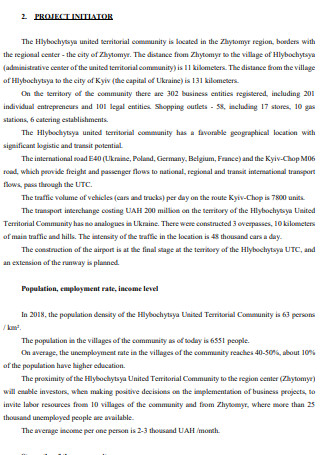
Logistics Center Investment Project Business Plan
download now -
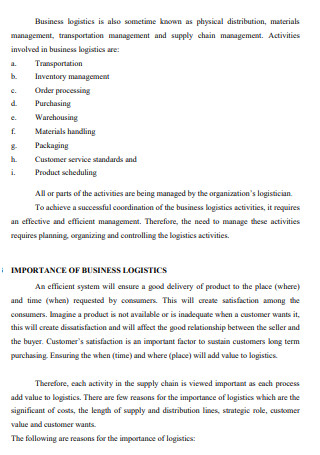
Overview of Business Logistics Plan
download now -
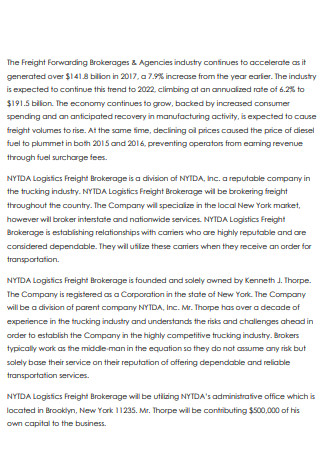
Logistics Brokerage Business Plan
download now -
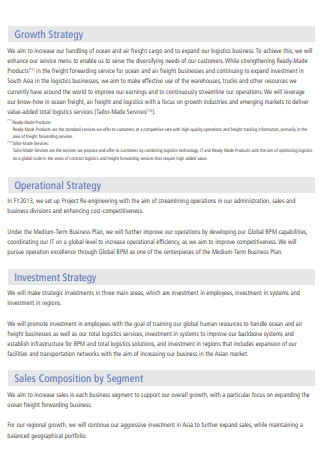
Logistics Medium Term Business Plan
download now -
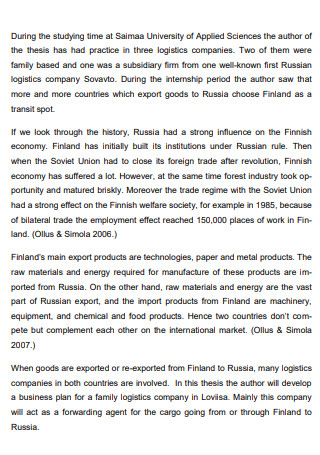
Logistics Company Business Plan
download now -
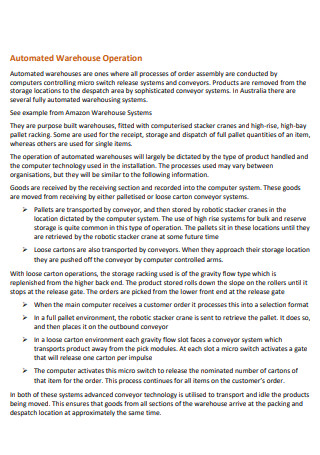
Logistics Business Plan
download now -

Developing Transport And Logistics Business Plan
download now
FREE Logistics Business Plan s to Download
6+ SAMPLE Logistics Business Plan
What IS a Logistics Business Plan?
4 Roles of Logistics in the Supply Chain
Creating the Logistics Business Plan
FAQs
What is demand forecasting in logistics?
What are the typical areas or aspects needed to start a logistics business?
What is third-party logistics?
What is freight forwarding?
What IS a Logistics Business Plan?
A Logistics business plan is a documented process on how a business achieves its smart goal when it comes to transportation, storage, and distribution of products. It is used by start-up logistics companies, but can also be used by any company that wants to set up its own logistics team. Logistics operation has continued to evolve and adapt to the changing times, as customers’ needs have become varied. The operation covers all types of industry. From inventory management, transportation, purchasing, storage and warehousing, consultation, and so on, of mail, parcel, small packages, big packages, to automobiles, to the highly industrialized equipment, logistics has the important role of ensuring timely procurement and delivery management within a supply chain operation.
4 Roles of Logistics in the Supply Chain
Logistics is all about distribution, the delivery of products or goods. Logistics aim for distribution that costs less, has a high-efficiency rate, effective inventory control management, effective storage and warehouse management, and a good customer experience through the timely and safe delivery of products. Logistics is the physical fulfillment of supply chain management. The important responsibility it plays in sales and business operations cannot be undermined. The success of sales planning depends on the distribution of products at strategic locations. The success of marketing planning depends on the delivery of resources and materials used for marketing activities. Logistics is a big operation, and it plays the following roles in supply order, or supply chain management.
Creating the Logistics Business Plan
A logistics business plan can be used for start-up logistics companies or company in-house logistics teams. The business plan should cover all aspects that involve the movement of products but should be kept simple enough to be easily understood. The business plan also serves as a roadmap, a guide for the company on how to go about achieving operational, marketing, and financial goals. There is no hard and fast rule when it comes to formatting a business plan. A logistics business plan should be flexible enough to cover both the company and customer requirements. Here are the following elements that are commonly included in a logistics business plan.
-
1. Executive Summary
The executive summary provides a brief overview of the logistics group or company, its goals and objectives, and a summary of steps on how to go about achieving those goals. It also provides detail on logistics and distribution services being offered by the company. The executive summary should be drafted that ultimately grabs the reader’s interest and makes them want to go through the whole plan. Executive summaries often contain the mission and vision statement. A logistics business plan mission statement contains the purpose of the whole plan. It captures the whole culture and values of the company. United Parcel Service, an American multinational logistics company, has a good example of a mission statement.
The mission statement goes: “What We Seek to Achieve: Grow our global business by serving the logistics needs of customers, offering excellence and value in all that we do. Maintain a financially strong company-with broad employee ownership-that provides a long-term competitive return to our shareowners.” A vision statement describes what the company hopes to achieve, typically in a given timeframe. It sets the tone of urgency for the business, ultimately inspiring and motivating employees to consistently work towards accomplishing the company’s goals. Reliance Logistics Group, another world-renowned logistics company, has a strong vision statement. The first few lines of their vision statement go: “Our aim is to act as an indispensable partner to our clients by helping them build and maximize sustainable competitive advantages. We do this by helping them get their products to market quickly, efficiently, and safely.”
-
2. Market Analysis
The market analysis in a logistics business plan checks the market’s condition if there’s a current demand or need in the market, as well as existing competition profiles. This analysis will provide the basis for coming up with a marketing strategy. It also looks at the market size, current trends, forecasting or market outlook, and including the target market. Looking at the target market meant classifying the target customers according to demographics. On a regular business plan, customers are typically classified according to age, gender, income, lifestyle, location, culture, affiliations, and so on. In a logistics business plan, location is given the utmost importance. Another way of doing market analysis is by SWOT analysis. SWOT analysis is the Strengths, Weaknesses, Opportunities, and Threats that could affect the logistics business.
Strength is all about the features of the company that make it stand out and/or succeed. Strengths of a logistics company could be having an existing, diversified customer portfolio, expertise in logistics, expertise in inventory and warehousing management, and/or acquisition or increased presence of the logistic company in strategic locations. Weaknesses are those factors limiting the success of the logistics company. Weaknesses could be labor-intensive or lack of the latest technology software, poor customer profiling, or lack of presence in significant media channels. Opportunities are those features or aspects that the company can leverage to achieve a successful business. Opportunities in logistics could be building more field offices and storage facilities to broaden customer reach, using social media or social networking platforms to increase presence in the market, and/or availing the latest software technology to apply to the inventory and warehouse management process. Threats are those factors that could potentially harm the logistics business. It could be in the form of the increasing presence of logistics competitors and/or extreme weather conditions.
-
3. Marketing Strategy
A marketing strategy deals with how the logistics company plans to win over the market. It also includes marketing and advertising campaigns to increase the company’s presence in the market. A marketing strategy should always be anchored on the business plan’s goals, objectives, including the mission and vision statement. It should also be well-defined, bound to a timeline, and should have a budget allocated. One example of a logistics marketing strategy is increasing the presence of the business online or through social media and social networking sites. Online presence could be creating the logistics company website, blogging or vlogging, and/ or utilizing search engine optimization to rank the logistics company at the top of any logistics online search.
It could also be through pay-per-click online marketing, where website users are led to the company’s website upon clicking on their ads. Another marketing strategy could be increasing the presence of field offices that would make it more accessible for customers to drop off or pick up their items. Having value-added services is another marketing strategy. A value-added service in logistics could be the company picking up items to be delivered directly from customers’ homes, instead of the customers coming to their office to drop off their delivery, making it convenient and time-saving for them. Another strategy is having a good customer service group that is trained to effectively address, solve, and assist the customers with whatever logistic concerns they have.
-
4. Financial Planning
Financial planning in a business plan is all about the financial information and financial projections of the logistics company. It includes the financial statement and balance sheet, with details on the budget or capital versus the operation costs and expenses. The financial planning section is important, especially for new start-up logistics companies. This part is usually significant for potential investors, as investors would like to check and see how feasible the current financial situation of the company is and if the financial projections are measurable.
FAQs
What is demand forecasting in logistics?
Logistics play a significant role in the supply chain operation of a company. That’s why demand forecasting is important. Demand forecasting is advanced predicting of the supply needs of the company, and anticipating the demands of the market if there is enough in the inventory to cover supply demand. Demand forecasting ensures that a business never runs out of supply to distribute.
What are the typical areas or aspects needed to start a logistics business?
To start a logistics business, you need to have a good infrastructure or facility in place. Aside from having a main office, you need to have facilities for storage or warehousing and field offices to accept shipment, delivery, drop-off, or pick-up. You also need to have a good and effective staff or employees in place. The employees should be well-trained in a specific area of logistics, as well as in customer service. Having the right transportation in place is also crucial. The transportation should be specific to the delivery services offered by the company. Another is having the right equipment in place. For large and bulk size items, the logistics company would require a forklift, conveyor belts, truck fleet, et cetera. Having a good IT infrastructure is also important to make the transportation, inventory, and warehousing management system fast and easy to use.
What is third-party logistics?
A third-party logistics (3PL) company is an outsourced logistics company. They are hired by a separate company to perform the company’s logistics operations. Having third-party logistics is beneficial to a company, since it’s cost and time saving, and doesn’t require a company to have its physical warehouse for delivery.
What is freight forwarding?
Freight forwarding is headed by a separate company that arranges the transportation of goods or cargoes of other companies through a logistics company. They typically handle the consignments, route identifying, and documentary requirements needed for transporting goods by the logistics company.
Logistics plays a very important role in any kind of business. They are at the core of the supply chain operations, making sure that the company stays on top of the market demands through effective product distribution and supply management. To stay on top of the game, logistics need to have a game plan. And that game plan is called the logistics business plan.
Starting your own logistics business can be a challenging task. But with the help of our logistics business plan templates, you’ll be on your way to being the number one trusted logistics company in the market. Download our logistics business plan template now!
